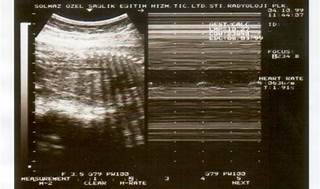A nurse is caring for a client who is at 38 weeks of gestation and has a score of 10 on her biophysical profile. Which of the following actions should the nurse take?
Administer oxygen and notify the provider.
Assure the client that the score is within the expected range.
Offer the client orange juice and repeat the assessment in 1 hr.
Assist the client into a side-lying position.
The Correct Answer is B

The correct answer is choice B. Assure the client that the score is within the expected range.
Choice A rationale:
Administering oxygen and notifying the provider is not necessary for a biophysical profile (BPP) score of 10. A score of 10 indicates that the fetus is well-oxygenated and there are no signs of distress.
Choice B rationale:
A BPP score of 10 is considered normal and reassuring, indicating that the fetus is well-oxygenated and there are no signs of distress. Therefore, the nurse should assure the client that the score is within the expected range.
Choice C rationale:
Offering the client orange juice and repeating the assessment in 1 hour is not necessary for a BPP score of 10. This action might be considered if the score were lower and there was a need to reassess fetal well-being.
Choice D rationale:
Assisting the client into a side-lying position is not required for a BPP score of 10. This position is typically recommended to improve uteroplacental blood flow in cases of fetal distress or lower BPP scores.
Nursing Test Bank
Naxlex Comprehensive Predictor Exams
Related Questions
Correct Answer is D
Explanation
Choice D rationale:
The correct answer is Choice D. The biophysical profile is a prenatal test used to assess fetal well-being in the third trimester of pregnancy. It is not used to determine the estimated date of birth (Choice A), as that is typically calculated based on the first day of the last menstrual period and confirmed or adjusted by early ultrasounds.
The test also does not require the client to be NPO (nothing by mouth) for 8 hours prior to the test (Choice B). This restriction is commonly associated with certain medical procedures, but it is not applicable to the biophysical profile.
Furthermore, there is no need to initiate an IV (intravenous line) before the biophysical profile (Choice C). The test is non-invasive and involves the use of ultrasound and fetal heart rate monitoring. The biophysical profile assesses several fetal parameters, such as fetal movement, fetal tone, fetal breathing movements, amniotic fluid volume, and the fetal heart rate. These parameters help evaluate the well-being and health of the baby. The test is often recommended in cases of high-risk pregnancies, decreased fetal movement, or other conditions that may warrant closer monitoring of the baby's condition. By knowing that the biophysical profile predicts fetal well-being in the third trimester, the nurse can provide accurate information to the client, reassuring them about the health of their baby and explaining the importance of the test in ensuring a safe delivery and healthy outcome.
Correct Answer is D
Explanation
Choice A rationale:
Rh incompatibility is not relevant in this scenario. Rh incompatibility refers to a condition where the mother's blood is Rh-negative, and the baby's blood is Rh-positive, which can lead to hemolytic disease of the newborn. However, this condition is unrelated to the client's current presentation of heavy, red vaginal bleeding without contractions.
Choice B rationale:
Frequency and duration of contractions are not the primary concern in this situation. The client's main complaint is heavy vaginal bleeding without contractions, which indicates a potential issue with the placenta or other pregnancy-related problems.
Choice C rationale:
Fetal lung maturity is not the priority at this stage. The client is at 38 weeks of gestation, which is considered full term. Fetal lung maturity is typically assessed if there's a need for early delivery, which is not indicated in this scenario.
Choice D rationale:
The correct choice. The client is experiencing heavy, red vaginal bleeding, which may be a sign of placental abruption, where the placenta separates from the uterine wall prematurely. Determining the location of the placenta through an ultrasound can help identify if placental abruption is the cause of bleeding. Placental abruption can be a serious condition that requires immediate medical attention.
Whether you are a student looking to ace your exams or a practicing nurse seeking to enhance your expertise , our nursing education contents will empower you with the confidence and competence to make a difference in the lives of patients and become a respected leader in the healthcare field.
Visit Naxlex, invest in your future and unlock endless possibilities with our unparalleled nursing education contents today
Report Wrong Answer on the Current Question
Do you disagree with the answer? If yes, what is your expected answer? Explain.
Kindly be descriptive with the issue you are facing.
